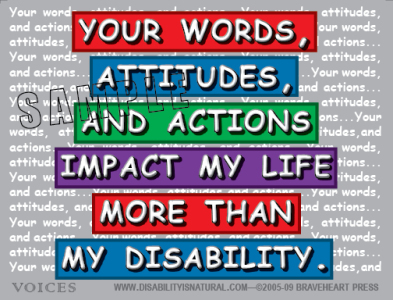The Importance of Positive Communication to People with Disabilities
As society progresses towards full inclusion of people with disabilities, it is important that people without a developmental disability learn how to relate to those with a disability in respectful ways. Knowing how to use appropriate language is a key to making positive change, so CLPS is reprinting this article from the most recent Shriner Newsletter because it offers helpful information about how to use language that is respectful to all. Here are the basics…
Reprinted from: THE PUBLIC RELATIONS VOICE December 2014 One Look, One Voice
The Importance of Positive Communication to People with Disabilities
As we continue to work together for the benefit of people with disabilities and families, it is very important to be mindful of the effect of the words we choose to use. There are words that may have been acceptable in the past; but are not any longer. Language is fluid and changes with the times, and we must be aware of those changes, in order to avoid making a negative impression.
The Power of Language
Children, especially, are deeply influenced by the language surrounding them. Being aware that language can affect the development of a positive attitude is critical.
- When referring to people with a disability, please remember to avoid labels with a negative connotation, such as:
- “crippled”
- “handicapped”
- “lame”
- “deformed”
The preferred word choice is usually:
- “disability”
- “disabled”
- the actual term involved, such as, “cerebral palsy” or “muscular dystrophy”
*Always remember to use language that encourages, rather than discourages, the individual.
Understanding that People with Disabilities are People First
The second key element of communicating positively with people with disabilities is using “people-first language,” where the person is the important element, not the disability.
- For example, try using phrases such as “a person with cerebral palsy” or “a person who uses a prosthetic arm,” rather than defining them by the disability itself.
- Another important aspect of using people-first language is to avoid negative descriptive phrases and terms, such as:
- “confined to a wheelchair”
- “wheelchair bound”
- “a victim of X”
- “stricken with X”
- “suffering from X”
Instead, try saying a person “uses a wheelchair,” or “has X.”
Also avoid value-laden words and phrases, whether negative or positive, because even seemingly positive labels such as “courageous” and “inspirational” can be burdensome to a child, setting unnecessary high expectations just because they are disabled.
As an alternative, encourage personal value and independence, allowing the person to tell their own story and to speak for themselves.
As part of using people-first language, it is also imperative to not define people by their disabilities. Instead, emphasize abilities, not limitations. For instance:
- It is better to say: “Darlene is an excellent writer,” rather than, “Despite her disability, Darlene is an excellent writer.”
- It is also preferable to say, “Johnny is a child with a disability,” instead of the defining, “Johnny is a disabled child.”
Taking steps to create a positive atmosphere via language will help people with a disability become more confident and accepting of their disability and the world around them, which will help them transition into successful, productive adults.
For more information on using People First language visit this website: http://www.disabilityisnatural.com/

